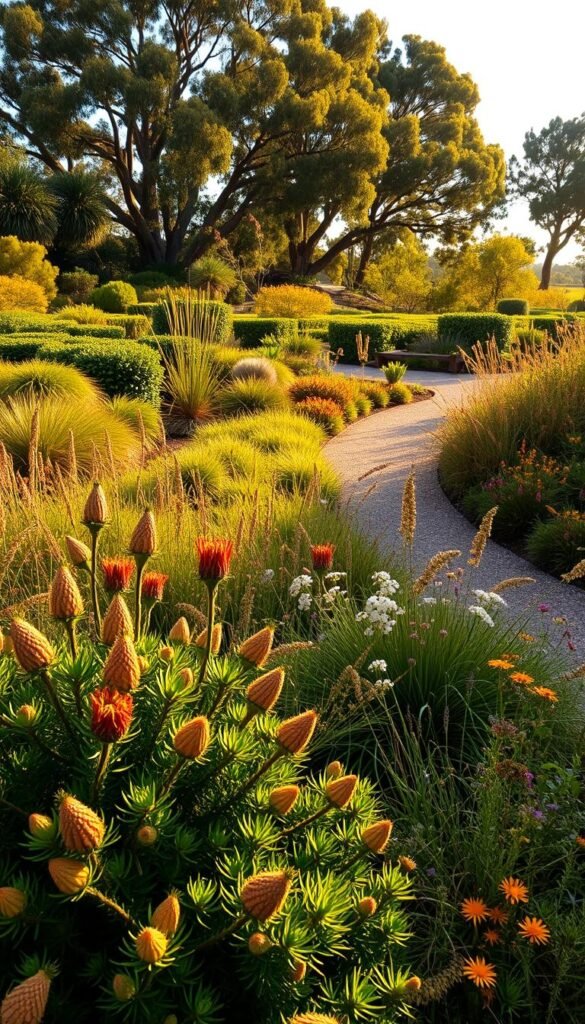Transforming your outdoor space into a vibrant sanctuary doesn’t require exotic species. By working with native plants, you create a living tapestry that reflects your region’s unique character. These landscapes thrive naturally, needing less water and care while supporting local ecosystems.
Imagine a yard filled with textures and colors that change with the seasons. From drought-tolerant grasses to flowering shrubs, regional flora offers surprising versatility. You can design relaxed, natural layouts or structured modern arrangements—the choice depends on your vision.
What makes these spaces special? They become habitats for butterflies, birds, and pollinators. Unlike high-maintenance lawns, they grow stronger over time. Less work means more time to enjoy your outdoor haven.
Ready to start? Begin by observing plants thriving in nearby wild areas. Pair them with complementary species for visual harmony. For creative design strategies, consider layered planting heights and natural materials like stone pathways.
Your landscape will evolve into more than decoration—it becomes a testament to your environment’s natural beauty. Every bloom and leaf tells a story of place, resilience, and connection.
Understanding the Unique Appeal of Australian Native Gardens
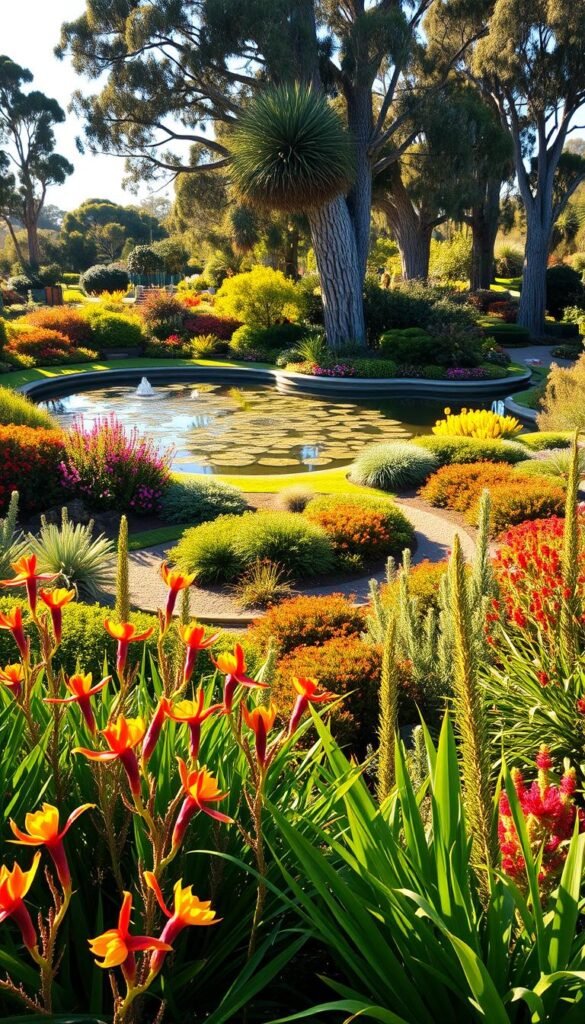
Creating a thriving habitat starts with choosing plants that belong. Regional species naturally harmonize with their surroundings, offering benefits that extend far beyond their beauty. These spaces become living classrooms where every bloom and leaf strengthens your connection to the land.
Environmental and Aesthetic Benefits
What if your yard could do more than just look pretty? Native plants feed birds with protein-rich seeds and shelter insects in their bark. They need up to 60% less water than non-native species, saving you time and resources.
Seasonal shifts become spectacles. Bottlebrush spikes erupt in crimson, while silvery grasses dance in breezes. “My garden feels alive in ways turf never did,” shares a homeowner who transitioned last spring.
Connecting with Local Ecosystems
Your choices ripple through food chains. By supporting local pollinators and wildlife, you help sustain delicate ecosystems. Lizards bask on sun-warmed rocks, while honeyeaters sip from grevillea blossoms.
These gardens engage all senses. Crunchy leaf litter underfoot. Minty eucalyptus scents after rain. Over time, you’ll recognize returning butterflies—nature’s thank-you notes.
Assessing Your Site for a Thriving Native Garden
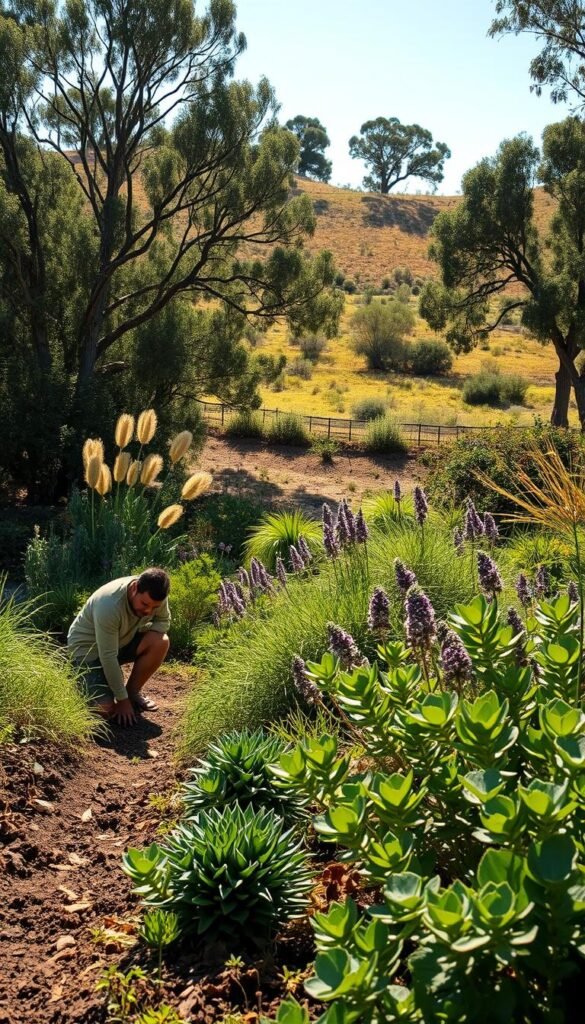
Your yard’s success begins with understanding its natural blueprint. Every space has unique soil composition, light patterns, and microclimates. These factors determine which species will flourish and which might struggle. Spend time observing how sunlight moves across your plot and where water pools after rain.
Soil, Sunlight, and Moisture Considerations
Start by grabbing a handful of earth. Does it clump like clay or crumble like sand? Most regional species thrive in slightly acidic to neutral soil. Test pH levels using a kit from your local nursery. If water drains too slowly, mix in gypsum for clay-heavy ground. Sandy soils benefit from hydrogels that lock in moisture.
Track sunlight exposure for 3 days. Full-sun lovers like banksias need 6+ hours of direct light. Shade-preferring species like tree ferns thrive under dappled light. For small spaces with limited ground access, consider vertical planters to maximize light use.
Evaluating Climate and Wind Exposure
Coastal breezes carry salt that can scorch leaves. In these areas, choose tough species like coastal rosemary. Inland gardens might need windbreaks for delicate plants. Use this table to match species to your conditions:
| Climate Zone | Soil Type | Recommended Plants |
|---|---|---|
| Coastal | Sandy | Saltbush, Pigface |
| Inland | Clay | Kangaroo Paw, Grevillea |
| Mountain | Loamy | Snow Gum, Alpine Mint |
Remember: Your observations today create tomorrow’s thriving ecosystem. What works for your neighbor’s yard might not suit yours—nature loves variety!
Selecting the Perfect Australian Native Plants
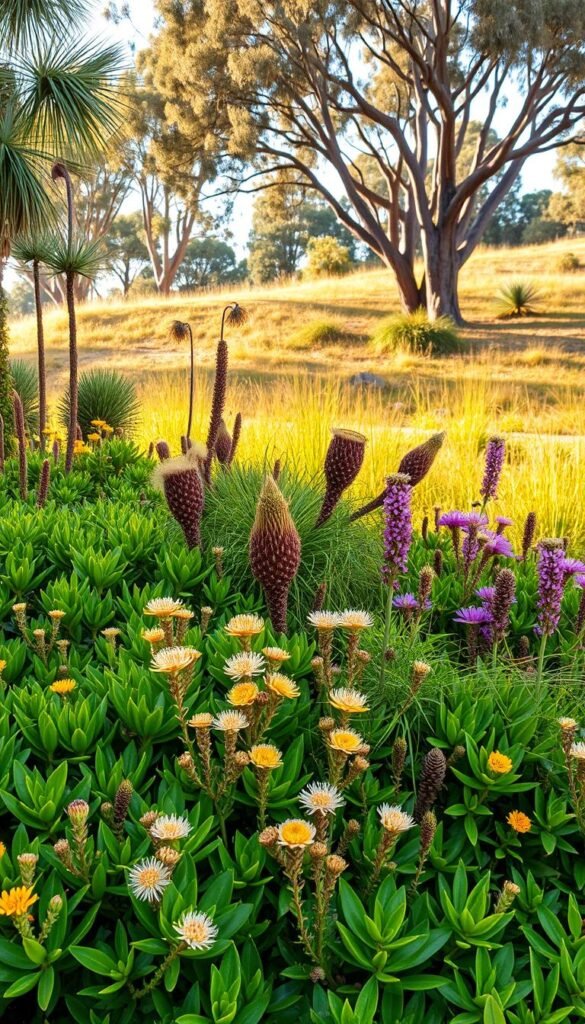
Curating your landscape begins with smart plant partnerships that thrive in your unique environment. By aligning your choices with nature’s blueprint, you create spaces where species flourish with minimal effort. Let’s explore how to make selections that harmonize with your land’s personality.
Matching Plants to Your Local Conditions
Your soil type and sun exposure dictate success. Sandy, fast-draining earth? Kangaroo paws and bottlebrush species will reward you with vibrant flowers. Heavy clay? Try hardy lomandra grasses or correas.
Consider growth habits carefully. A banksia might start small but can reach 15 feet. Leave breathing room between shrubs for air circulation. “I learned spacing the hard way—crowded plants attract pests,” admits a gardener from Arizona.
Tips for Achieving Seasonal Interest
Keep your space lively year-round with staggered bloom times:
- Winter: Golden wattles brighten gray days
- Spring: Billy buttons add playful texture
- Summer: Red-flowering gums become bird magnets
Mix textures for visual drama. Pair feathery grasses with bold grevillea blooms. Include seed-producing plants like hakeas to sustain local wildlife. Your plant selection becomes an ever-changing canvas that celebrates each season’s unique gifts.
Remember—your preferences matter. Love architectural forms? Add a grass tree centerpiece. Prefer softness? Silver bush becomes a moonlit focal point. When conditions and creativity unite, magic happens.
Australian Native Garden Design: Incorporating Local Flora into Your Landscape
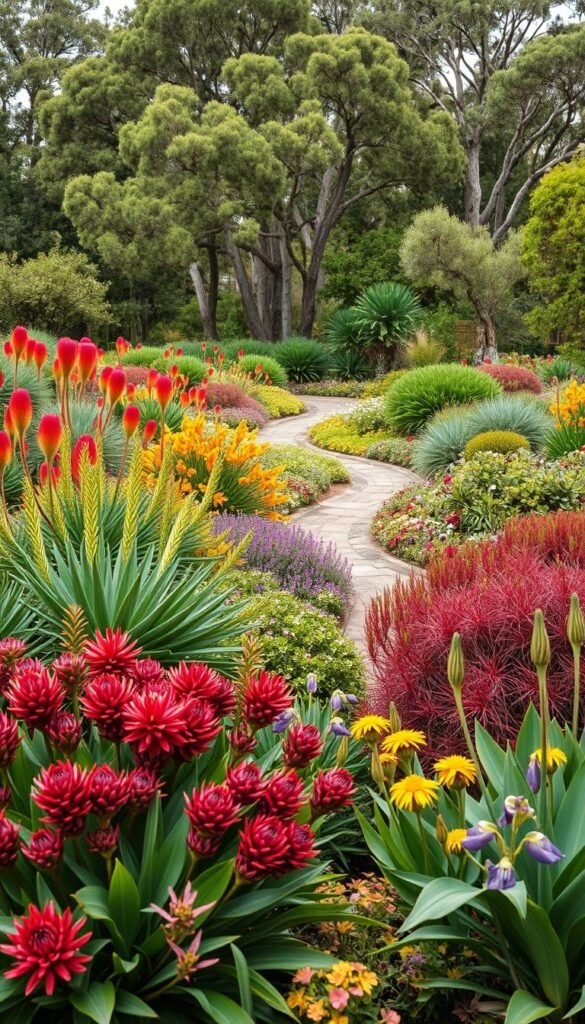
Crafting a living masterpiece starts with smart arrangements that honor your land’s natural rhythm. Let’s explore how thoughtful layouts and purposeful features turn ordinary yards into thriving ecosystems.
Detailed Planting and Layout Strategies
Repeat key elements to create visual flow. Try clusters of kangaroo paws in three corners of your plot. Their fiery blooms become connecting threads. Mix textures using feathery grasses beside leathery grevillea leaves.
Balance bold and subtle elements. Place taller shrubs behind low-growing groundcovers. This layering mimics natural landscapes. For sustainable design principles, use plants that share water needs in each zone.
| Garden Style | Key Plants | Signature Feature |
|---|---|---|
| Coastal | Banksia, Pigface | Wind-resistant shrubs |
| Dry Climate | Emu Bush, Bottlebrush | Rock mulch beds |
| Urban | Dwarf Lilly Pilly | Vertical green walls |
Creating Functional Outdoor Spaces
Define areas without harsh borders. A meandering path of crushed granite leads to a seating nook. Surround it with fragrant mint bushes that release scent when brushed.
Incorporate water wisely. A small pond with native rushes filters runoff while attracting frogs. For eco-friendly hardscaping ideas, use local stone for edging beds.
Screen unwanted views naturally. Plant lemon-scented gums along property lines. Their height increases privacy while hosting parrots. Every choice should serve both beauty and purpose.
Implementing and Maintaining Your Native Garden
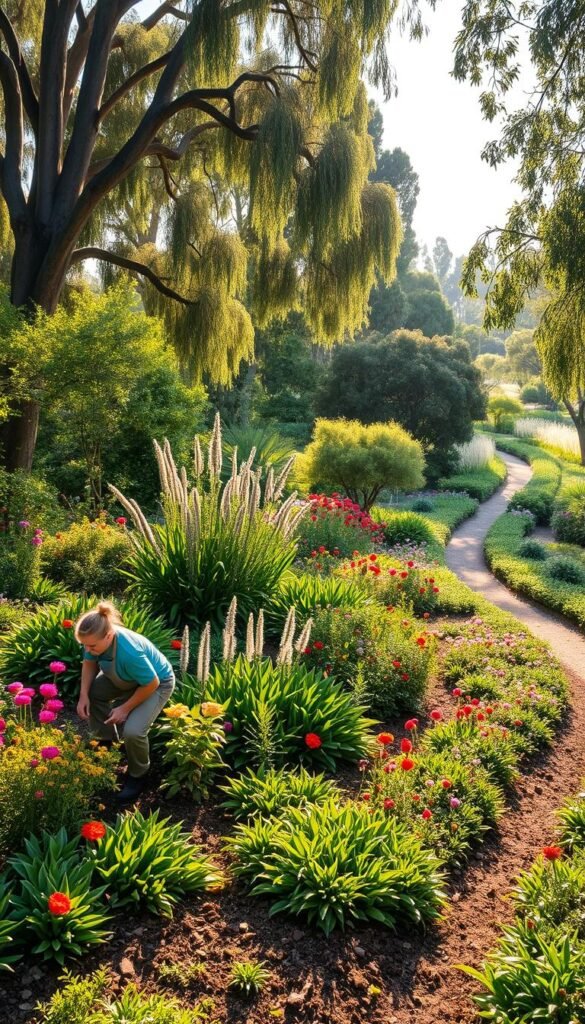
Bringing your garden vision to life starts with smart groundwork. Proper setup ensures your plants thrive while reducing long-term upkeep. Let’s explore how to turn your prepared site into a resilient, self-sustaining ecosystem.
Site Preparation and Planting Basics
Clear weeds and debris first—this gives your new plants room to grow. Test your soil to determine amendments. Clay-heavy earth benefits from gypsum, while sandy areas improve with hydrogels. Mix in compost for nutrient-rich beds.
When planting, dig holes twice as wide as root balls. Position plants according to your design before burying roots. Backfill gently, ensuring stems sit at ground level. Water deeply to settle the soil and eliminate air pockets.
Watering and Mulching Strategies
New plants need consistent moisture. Use drip irrigation for efficient water delivery. Once established, switch to deep, infrequent soaking. This encourages strong root growth.
Apply 3-4 inches of chunky mulch around plants. It suppresses weeds, retains moisture, and regulates soil temperature. Replenish mulch every 2-3 years as it breaks down.
| Maintenance Task | Frequency | Tips |
|---|---|---|
| Pruning | After flowering | Shape plants, remove dead wood |
| Fertilizing | Yearly (spring) | Use low-phosphorus formulas |
| Pest checks | Monthly | Look for chewed leaves, sticky residue |
For eco-friendly pest control, try neem oil or insecticidal soap. Most natives resist diseases when given proper airflow and sunlight. Remember—healthy plants naturally fight off pests!
Your Journey to a Flourishing Native Garden
Your path to a vibrant outdoor space begins with thoughtful choices that nurture life. By selecting plants suited to your region, you craft a living sanctuary requiring minimal upkeep. These resilient species evolve with the seasons, offering shifting colors and textures that keep your space dynamic year-round.
Every shrub and flowering species becomes a haven for birds and beneficial insects. Consider adding a shallow water feature or leaving fallen leaves in corners—small acts that boost biodiversity. For inspiration on welcoming winged visitors, explore our guide to creating pollinator-friendly habitats.
Remember: successful spaces balance beauty and purpose. Group shrubs with similar water needs, and let taller plants shield delicate varieties from wind. Over time, your plot transforms into a self-sustaining ecosystem where nature handles most tasks.
Celebrate each milestone—the first butterfly visit, a burst of unexpected blooms. These moments remind you how native landscapes deepen your connection to the land while protecting its delicate balance. Your efforts today ensure thriving habitats for generations.

